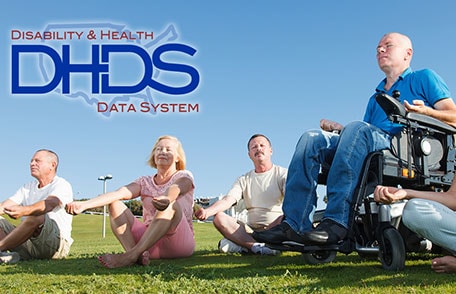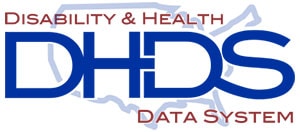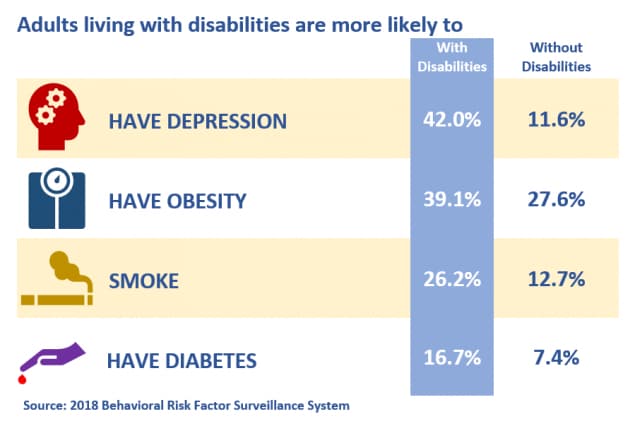Disability and Health Data Now

There are important health differences between people with and without disabilities. Do you know what they are in your state? The Disability and Health Data System (DHDS) can help you find out.
Disability doesn’t have to equal poor health. However, adults with disabilities are more likely to be obese,1 smoke,2 have high blood pressure,3 and be physically inactive.4 These are all preventable factors that can increase the risk for chronic diseases such as heart disease, stroke, diabetes, and some cancers,4-6 which are also more common among adults with disabilities.7
CDC created the Disability and Health Data System (DHDS) to provide the vital information needed to better understand the health needs of adults with disabilities at the state and national levels. Equipped with these data, state epidemiologists, researchers, policy makers, public health professionals and everyone interested in the health of adults with disabilities can plan for inclusive communities that offer the programs and services needed to improve the health of this population.
DHDS is
- Interactive—An online, easy-to-use data tool that provides state- and national-level data on approximately 30 health topics for adults with disabilities.
- Customizable—You can explore data by indicator (e.g., health topic) or by location, then customize maps, charts, and tables, making it easy to view information for your state.
Data Available in DHDS
DHDS includes analyzed data from 2016–2018 in the Behavioral Risk Factor Surveillance System (BRFSS) on
- Disability estimates
- *Disability status (any disability or no disability) and disability types (cognitive, mobility, vision, self-care, independent living, and hearing disability) overall; and
- By age, sex, race/ethnicity, veteran status.
*Respondents were defined as having any disability if they reported serious difficulty concentrating, remembering or making decisions (cognitive disability); serious difficulty hearing or deafness (hearing disability), serious difficulty walking or climbing stairs (mobility disability); serious difficulty seeing or blindness (vision disability); difficulty dressing or bathing (self-care disability); or difficulty doing errands alone (independent living disability).
- Demographics among adults with and without disabilities and by disability types
- Income level;
- Education level;
- Marital status; and
- Employment status.
- Approximately 30 health topics among adults with and without disabilities and by disability types, including
- Smoking;
- Obesity;
- Heart disease;
- Diabetes;
- Binge drinking;
- Flu vaccine; and
- Healthcare coverage.
With DHDS, you can answer questions, such as
- What is the percentage of adults with a disability in my state?
- How does this population vary by age, sex, and race/ethnicity?
- How does my state compare with other states and the nation?
- How does the percentage of depression, diabetes, obesity, or smoking vary among people with select disability types?
CDC’s Partners and State Programs are Using DHDS
“The students were astonished with how easy it is to use DHDS and how rich the data are. I had them practice finding disability and health data and building an argument around it to convince health professionals as to why people with disabilities should be a priority population.”
David Ellsworth – Health Services Policy Specialist, Ohio Disability and Health Program.
Ohio
The Ohio Disability and Health Program used DHDS to create a fact sheet on smoking data and cessation resources [222 KB] available to Ohioans with disabilities for use by health professionals, educators, disability advocates, and community members. The Ohio Disability and Health Program distributed the fact sheet through their social media, website, and email networks. They then contracted with the American Association on Health and Disability for dissemination to a national audience.
David Ellsworth, a health services policy specialist with the Ohio Disability and Health Program, gave a presentation to trainees at the Leadership Education in Neurodevelopmental Disabilities (LEND) program about “Big Data.” He discussed how databases, such as DHDS, can be used to inform partners to prioritize efforts that address the health needs of people with disabilities.
Additionally, DHDS was used as a resource to develop the Ohio 2017–2019 State Health Improvement Plan that determines statewide health priorities, including priorities for people with disabilities.
“I personally use the DHDS system to pull data not only for our Disability and Health Program, but also for classes I teach.”
Jean Hall – Director, Kansas Disability and Health Program.
Kansas
The Kansas Disability and Health Program works to teach the public about health differences faced by Kansans with disabilities. They have distributed more than 400 copies of CDC’s Kansas-specific “Disability Impacts All of Us” state profile page, which includes data from DHDS, and shared it with 200 family physicians.
The Kansas Disability and Health Program presented to the Kansas Disability Caucus on teaching Centers for Independent Living providers, disability advocates, and consumers about how to use DHDS and other data systems to access statistics about people with disabilities.

Use DHDS to help improve the health and the well-being of adults with disabilities in your state.
You Can Use DHDS to
- Identify health differences between adults with and without disabilities overall and by age, sex, and race/ethnicity;
- Download data for use in presentations, reports, or fact sheets;
- Inform partners, policymakers, and communities about the health of adults with select functional disability types; and
- Make the case for the inclusion of people with disabilities in community programs and services they need to improve their health.
References
- Weil E, Wachterman M, McCarthy EP, et al. Obesity among adults with disabling conditions. JAMA. 2002; 288:1265–1268.
- Courtney-Long E, Stevens A, Caraballo R, Ramon I, Armour BS. Disparities in current cigarette smoking prevalence by type of disability, 2009–2011. Public Health Rep. 2014;129(3):252–60.
- Stevens A, Courtney-Long E, Gillespie C, Armour BS. Hypertension among US adults by disability status and type, National Health and Nutrition Examination Survey, 2001–2010. Prev Chronic Dis. 2014;11:E139.
- Hollis ND et al., Physical activity types among US adults with mobility disability, Behavioral Risk Factor Surveillance System, 2017. Disabil Health J. 2020:100888. https://doi.org/10.1016/j.dhjo.2020.100888
- Department of Health and Human Services (US). The health consequences of smoking: A report of the Surgeon General. Washington: HHS, Centers for Disease Control and Prevention, National Center for Chronic Disease Prevention and Health Promotion, Office on Smoking and Health (US); 2004.
- Chobanian AV, Bakris GL, Black HR, Cushman WC, Green LA, Izzo JLJr, et al. Seventh report of the Joint National Committee on Prevention, Detection, Evaluation, and Treatment of High Blood Pressure. Hypertension. 2003;42(6):1206–52.
- Okoro CA, Hollis ND, Cyrus AC, Griffin-Blake S. Prevalence of disabilities and health care access by disability status and type among adults — United States, 2016. MMWR Morb Mortal Wkly Rep. 2018;67:882–887. DOI: http://dx.doi.org/10.15585/mmwr.mm6732a3External























.png)











No hay comentarios:
Publicar un comentario